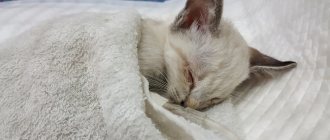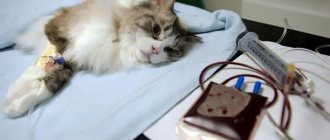Parasitic organisms live at the expense of other creatures, robbing them of useful microelements. Against the background of nutrient deficiency, extensive intoxication occurs with waste products of parasites, therefore, the internal organs of the infected person lose their functionality. In severe and advanced cases, this can lead to death.
Some parasitic diseases of domestic animals pose a serious danger to humans. For this reason, owners should know the main symptoms of the presence of parasites in cats, which depend on the type of pathogen.
Types of parasites in domestic cats
Parasites in cats are divided into internal and external. The former are called endoparasites, and the latter – ectoparasites.
Depending on the location of parasitism, cutaneous and subcutaneous ones are also distinguished. They are external, but affect different layers of the skin. This affects symptoms.
Skin
Representatives of this group live on the outer layer of the epidermis, that is, directly on the skin and in the hairs. The main method of infection is contact. Animals become ill through direct interaction with infected individuals and through contact with their personal belongings (feeders, beds, combs).
Fleas
The most problematic type of ectoparasites are fleas. Depending on their preferred food source, they come in cat, dog, rat and human varieties. The first are record holders for survival in difficult conditions, so most often you have to fight with them.
The size of the flea is no more than 0.5 cm, but after feeding the insect increases in size. It is held on the body by numerous spines and bristles, and uses a piercing-sucking mouthparts to suck blood.
IMPORTANT!
Unlike their counterparts, cat fleas do not disdain other types of blood. They easily change owners and can move to a dog or a person.
Ixodid ticks
Like fleas, these microscopic arthropods also feed on blood. They are also united by the possibility of carrying pathogens of other deadly diseases (helminthiasis, piroplasmosis, borreliosis, encephalitis) in their saliva.
After consuming blood, the tick increases from 0.3-0.4 cm to 1 cm. This makes it easier to detect.
Females cause the most damage. They bite deeper into the skin than males, which is fraught with severe inflammation and sepsis. Maximum activity is observed from the beginning of spring to the end of autumn, in the south of the country - from October-November and until May.
Lice-eating lice
Lice eaters are the smallest ectoparasites with a narrow body and a wide head. Their length is 0.1-0.2 cm. Unlike fleas and ticks, lice eaters do not know how to extract blood on their own and feed on it only from scratching. The rest of the time they eat keratinocytes - hair and skin cells.
Lice eaters also have a longer duration of parasitism. They remain on the owner until the end, which reduces the likelihood of infecting other animals.
Subcutaneous
Subcutaneous parasites in cats include 4 types of ticks. They live in the inner layers of the skin, so to detect them, a scraping must be taken from a sick animal.
Otodectes cynotis
Parasitizes the outer and inner parts of the ear. Causes otodectosis, which is easily identified by a nauseating putrid odor, severe itching and dark specks in the ears. The maximum size of the exciter reaches 0.75 mm.
Notoedres cati
This mite causes pruritic scabies, or notoedrosis. Its body length is 0.5 mm, and its main habitat is the outer part of the ears. Symptoms of the disease include dark gray discharge from the ears and matted hair.
Sarcoptes scabiei
The smallest representatives of this species reach only 0.14 mm in length. They parasitize the entire surface of the body and cause sarcoptic mange. The main symptom of this disease is thin lines of light gray color that appear on the affected areas. A small bubble can be found at their base.
Demodex cati
Despite their similar sizes (0.2-0.3 mm), these mites are classified as opportunistic. They are in the body from birth, but can cause demodicosis with a sharp drop in immunity. They live in hair follicles and sebaceous glands.
Domestic
Feline endoparasites include protozoa, various types of worms (helminths) and blood parasites. Both affect internal organs, but the latter focuses on blood vessels.
Protozoa
This group includes Toxoplasma and Coccidia. The peculiarity of feline toxoplasmosis is that mustachioed pets act as the main hosts, and not intermediate ones. In their body, Toxoplasma goes through the entire development cycle, which contributes to an increase in their number and the severity of the disease. New protozoa are formed by division in infected cells and sexual reproduction in the intestine.
Coccidia in cats is also an intestinal parasite and causes severe dehydration. Because of this, coccidiosis is very difficult for kittens to tolerate. Frequent bouts of vomiting and constant diarrhea lead to a sharp weakening of the immune system, which increases the likelihood of a secondary infection.
Helminths
The routes of infection by worms depend on their type. All existing pathogens can be divided into 3 groups:
- Nematodes (round)
. They enter the body along with contaminated food or through damaged areas of the skin and mucous membranes.
- Trematodes (flat)
. They are widely distributed. Infection occurs when drinking water from fresh water bodies or eating their inhabitants.
- Cestodes (tape)
. The largest representatives, reaching up to 10 m in length. Transmitted through the bites of blood-sucking insects.
The symptoms of helminthiasis depend on the location of the infection. According to this criterion, worms are classified into intestinal, pulmonary, heart and liver.
IMPORTANT!
Lungworms have a long incubation period (up to 6 months). At an early stage of the disease, they can only be detected using special equipment.
Blood parasites
Representatives of this group destroy blood cells. These include:
- Hemobartonella
. Penetrates into red blood cells, causing an autoimmune reaction. An infected organism attacks not only diseased cells, but also healthy cells. Because of this, acute anemia and oxygen starvation develops.
- Pyroplasmas
. Carried by ixodid ticks. Most often found in dogs and also in wild cats. Cases of infection of domestic “whiskers” with piroplasmosis were confirmed by German veterinarians in 2013. The risk group includes Siamese.
- Rickettsia
. Unlike other types, these pathogens penetrate not into red blood cells, but into platelets and lymphocytes. Like piroplasmas, they enter the body through ticks.
The cat family is mainly diagnosed with hemobartonellosis. Cases of piroplasmosis and rickettsiosis (erlichiosis) are very rare, but veterinarians still recommend following basic measures to prevent these diseases.
lice eaters
Small (1-2 mm long) wingless insects with a body flattened in the dorsoventral direction. The head is wider than the chest, flat, quadrangular. The mouthparts are gnawing type. The eyes are poorly developed. The chest consists of three and the abdomen of nine segments. The abdomen is longer than the head and chest combined.
Lice eaters are permanent ectoparasites. Development according to the type of incomplete transformation. Females lay eggs, gluing them to the root part of the hair with the uterine secretion. The development cycle is the same as that of lice.
Epizootological data. Insects (ectoparasites) of dogs are ubiquitous. Found on animals at all times of the year. Fleas are poorly adapted to certain types of animals and can spread from dogs to humans. Dog lice and lice parasitize only dogs.
Infection of animals occurs through direct contact between healthy animals and infected animals, as well as through care items.
Parasites are transmitted to puppies from their mother. Ectoparasites on dogs are more common under unsatisfactory conditions of keeping them in damp rooms and poor nutrition.
Insects can be mechanical and biological carriers of pathogens of invasive, infectious and viral diseases. Thus, dog, cat, human fleas, and dog lice eaters are intermediate hosts of the cestode.
Pathogenesis
Fleas and lice, when sucking blood, pierce the skin and inject saliva, which has toxic properties. In intensively infested patients, erythropenia develops.
Ectoparasites, crawling over the body of animals and biting them, cause itching and scratching, leading to the development of dermatitis. At the same time, dogs are deprived of rest, their attention, obedience and performance decrease, and the animal spends a lot of energy fighting ectoparasites.
Symptoms of ectoparasites
The main sign of infection with ectoparasites is a skin reaction. It includes the following symptoms:
- redness;
- inflammation;
- ulcerations;
- suppuration;
- local or total hair loss;
- dandruff;
- severe itching.
Due to constant scratching, the animal's body quickly becomes covered with bloody crusts. Bacteria and other pathogenic organisms easily penetrate into the lesions, complicating the course of the underlying disease.
Methods of infection
The most common type of infection in any pet is oral. If a cat is allowed to walk on its own, then this type can be realized by eating caught infected birds or rodents, grass, drinking water from dirty ponds and puddles , found spoiled or raw fish and meat, contact with contaminated feces, and so on.
Transdermal and intrauterine involvement is also likely.
Symptoms of worm infection in cats
Many common helminthiases have the same clinical picture. To begin with, the symptoms of cat worms affect the animal’s digestive system and its general well-being.
During helminthiasis, the owner pays attention to the consumption of obviously inedible foods (transformation of taste - parerexia), a complete absence or decrease in appetite , and significant weight loss in the cat. The animal is physically inactive, apathetic, weakened. The coat is dull, faded, disheveled, and ragged. Lacrimation, sclera and icterus of mucous membranes. Characterized by vomiting, nausea, bloating, impaired peristalsis, anal itching, as well as the presence of blood in mucus or feces. You can visually find dead or living helminths (parts thereof) in the area of the anus. During the examination, the veterinarian will detect an enlarged liver.
It should be noted that there is simply no one universal tablet against cat worms. The best results are shown by drugs and agents that have anthelmintic effects against several parasites.
Symptoms of internal parasites in cats
With endoparasites, the symptoms are more varied. They depend on the location of the lesion:
- Intestines. Weight loss, stool disturbances, vomiting and bloating are observed. If the problem lies in helminths, then a prolonged increase in their number can result in organ rupture.
- Lungs. Infection is accompanied by a hoarse cough, difficulty breathing, sneezing and pneumonia.
- Heart. In addition to breathing problems, cramps and fatigue are noted.
- Liver, gallbladder and pancreas. The main symptom is yellowing of the skin and mucous membranes. Abdominal pain and deterioration in coat quality are also possible.
With massive death of blood cells, anemia develops. It is characterized by pale or blue discoloration of mucous membranes, decreased body temperature, dilated pupils, rapid heartbeat and loss of consciousness.
NOTE!
With advanced helminthiasis, the worms come out along with feces and vomit. These symptoms require immediate veterinary attention, as otherwise the animal may die from intoxication.
Can lice pass from a cat to a person?
No, insects from a cat's fur do not pass on to humans. This is due to the structural features of insects. A person's body temperature is lower, so even if several parasites are specially transferred, they will not be able to live on a person's head.
Can lice pass from a cat to a person?
Parasites in kittens
Due to their weak immunity, kittens are at risk both in terms of the likelihood of infection and the severity of parasitosis. Their body is not adapted to prolonged dehydration, so without outside intervention, many babies die within the first two days.
Another problem concerns treatment. Antiparasitic agents are toxic, so ideally they should only be used for prophylaxis at regular intervals. The first pills are given to babies only 3 weeks after birth, and until this point, veterinarians recommend strict quarantine.
Intoxication is harmful not only for kittens, but also for pregnant cats. For this reason, animals must be dewormed before mating.
How to protect yourself from getting infected by parasites and insects from cats?
It is worth noting that some parasites can exist on their own for a long period of time. In this case, many larvae end up in the soil, where they live for quite a long time. That is why it is worth washing your hands after contact with soil.
Preventive measures to combat parasites:
- Wash your greens, vegetables and fruits. Since the soil may contain larvae and eggs of worms, everything that comes into contact with the soil should be washed well and doused with boiling water.
- Do not swim in prohibited areas. In the summer, in order to freshen up, people ignore warning posters and swim in ponds. The water may contain worm eggs.
- In summer, cover food with cloth or lids. Don't leave food directly on the table. Enough for a fly to sit on the product. This insect is a carrier of a huge number of ailments, including worms.
- Take care of animals. If you have a pet, don't leave it unattended. Carefully examine the feces and condition of the animal. If there is any suspicion of worms, give the animal an anthelmintic.
- Teach your child to wash their hands before and after eating. Children often dig in the sandbox, where infected cats can go to the toilet. It is enough for a child to lick his fingers for parasites to settle in the body.
- Boil and fry the meat well. Cattle also carry a large number of parasites. With insufficient heat treatment, worm eggs enter the digestive tract along with food. Infection occurs.
- Be sure to wash the trays where the animal goes to the toilet with bleach. There are also modern disinfectant liquids. With their participation, it will be possible to destroy worm eggs.
- Do not purchase products secondhand. This is especially true for dairy products and meat. High probability of infection from fruits and vegetables. Do not allow children to eat unwashed berries and fruits. Do not drink unboiled milk.
How to protect yourself from getting infected by parasites and insects from cats?
As you can see, cats are carriers of a huge number of parasites. Not all of them are transmitted to people. But a large number of worms are still capable of living in the human body.
What to do if cats are infected with parasites
Treatment options for cat parasites depend on the type of parasite, the age of the animal, and the severity of the disease. The main emphasis is on destroying the pathogen. Additional measures include relieving associated symptoms, a therapeutic diet, and external treatment of skin lesions.
Why is diagnosis by a veterinarian so important?
All the described symptoms are non-specific. They are characteristic not only of parasitic diseases, but also of systemic ones. In the latter case, treatment with antiparasitic drugs will not only not give the desired result, but will also aggravate the course of the disease due to increased intoxication.
We also must not forget about the danger of infecting others. Many of the described pathogens are transmitted to humans, so at least basic safety measures should be observed before making a diagnosis.
In addition to the external examination, diagnosis at the veterinary clinic includes the following studies:
- stool, blood and urine tests to detect helminth eggs and disturbances in the systemic blood flow;
- skin scrapings to determine the type of ectoparasite;
- light microscopy, revealing changes in the contour and color of red blood cells;
- smears and swabs from mucous membranes where toxoplasma lives;
- Ultrasound and x-rays assessing the general condition of internal organs.
Based on the data obtained, the veterinarian draws up an individual treatment plan. The duration of taking medications depends on the results of new tests, and until this point it is not recommended to deviate from the prescribed regimen.
Destruction of pathogens
Antiparasitic drugs are available in several forms. These include:
- Collars
. Repels ectoparasites. They are effective only as a preventive measure and often cause allergies.
- Shampoos
. Suitable for treatment and have hypoallergenic properties. The problem with using them is that very few cats like water treatments.
- Drops on the withers
. They are applied along the spinal column and destroy the pathogen in a short period. May provoke an allergic reaction.
- Sprays
. Basically they protect only the fur, that is, they are more suitable for prevention. Can be used not only on animals, but also on various surfaces.
- Pills
. They have the most powerful and long-lasting effect, but they are quite problematic to feed to a cat.
- Suspensions and pastes
. Unlike tablets, they have a more pleasant consistency and aroma. Suitable for treating kittens and capricious pets.
In addition to the listed remedies, the veterinarian may recommend antihistamines, hepatoprotectors, glucocorticosteroids, diuretics, antidiarrheals, antiemetics and probiotics. Their main task is to relieve associated symptoms and improve the functioning of the affected organs.
IMPORTANT!
Animals in serious condition are treated in a hospital with the help of droppers and oxygen chambers.
Additional measures, care and diet
Additional measures include treating the premises and the pet’s wounds. The patient’s personal belongings are boiled or thrown away, and all surfaces are treated with insecticidal sprays or soda solution.
When caring for an infected pet, it is important to remember to wash your hands after each contact. It is advisable to use rubber gloves. Until recovery, it is recommended to keep the cat in a separate room, preventing communication with other pets.
The therapeutic diet is prescribed individually, but in most cases it requires adherence to the following rules:
- Fractional meals. Small but frequent portions reduce the load on the gastrointestinal tract and facilitate the absorption of food.
- Focus on low-calorie but filling foods: chicken, turkey, cottage cheese.
When dry feeding, use medicated feed from a familiar manufacturer. This eliminates long-term addiction through gastrointestinal disorders.
Treatment
To destroy ectoparasites on the body of dogs, insecticides are used in the form of dusts, solutions, emulsions and aerosols. When choosing a drug, take into account the duration of its action and toxicity to the animal’s body. The effect of an insecticide depends not only on its form and quality, but also on the thoroughness of application to the skin of the animal.
All drugs have a stronger effect on the larvae, then on the adult forms, killing them, but do not have a detrimental effect on the eggs. In this regard, all treatments must be carried out at least twice: in the summer - after 10-12 days, in the winter - after 14-18 days. When using insecticides with a long residual effect, they are limited to a one-time treatment.
Dogs are washed with pet shampoo, which leads to the death of ectoparasites, cleansing of the skin and the disappearance of odor.
In the cold season, dusts of pyrethrum, 2% sevin, 3-5% chlorophos (10-30 g per animal) are used. During treatment (10-15 minutes), the animals are placed in a special bag with a purse-string suture to secure the upper part of the neck. It is recommended to carry out dust treatment outdoors or in a spacious, well-ventilated room. Make sure that the drug does not get into the feed. Persons carrying out processing must wear protective clothing, safety glasses and gauze masks.
They also offer for use a 0.75-1% aqueous solution of chlorophos, 0.5% aqueous emulsions of trichlorometaphos-3 and karbofos, 0.15% cyodrine emulsion, 0.25-0.5% suspension sevin, 0.5% ectobacterin suspension, 4% K soap emulsion, Akrodex aerosol and dermatosol.
What parasites pose a danger to humans?
Of the ecto- and endoparasites considered, you should be wary of fleas, ixodid ticks, toxoplasma and helminths. All of them, except toxoplasma, are transmitted by contact.
You can become infected with toxoplasmosis only during the removal of feces, and the disease itself is generally mild. Complications develop only with weakened immunity, so the risk group includes pregnant women, children under 3 years of age and the elderly.
Subcutaneous parasites and lice eaters are not dangerous to humans, since their mouthparts are not adapted for gnawing through our skin. They are also not happy with their lower body temperature compared to cats. In the worst case scenario, you will end up with bites and redness. The exception is sarcoptic mange (scabies).
Hemobartonellosis is an exclusively feline disease, so it is not transmitted to people or dogs. Transmission of other blood parasites is possible only through ticks. Also, do not be afraid of coccidia.
ADVICE!
Do not let your pet lick wounds on your skin until he gets better, and treat your hands with antiseptic or regular soap after each contact.
Can human lice live on cats?
No, this is impossible. Despite the external similarity, these are different lice. Parasites do not spread from humans to cats. And even if you specifically introduce lice from a person to a cat, they will not be able to live there.
Causes:
- Body temperature difference. The body temperature of cats and dogs is higher than that of humans. This environment is unfavorable for lice and they die.
- In addition, the structure of the hair is different. Accordingly, the structure and structure of the legs of insects is different. Human lice simply cannot cling to cat hairs with their paws. And they need exclusively human blood.
Can human lice live on cats?











